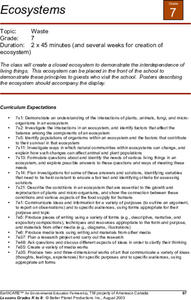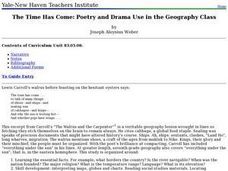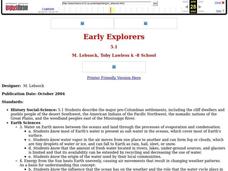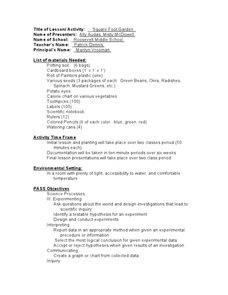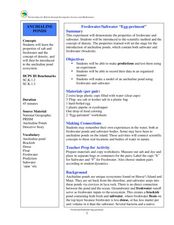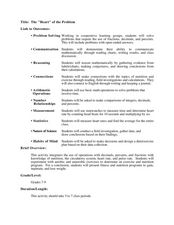Curated OER
Working Together to Solve a Problem
Students create a food and clothing drive at their school. In this philanthropy instructional activity, students listen to the story Selavi, That is Life, to help them understand homelessness. Then, students brainstorm ways to implement...
Curated OER
Bacteria
In this bacteria worksheet, students fill in the blanks with the correct word. Students then label the structures found on a bacterium.
Curated OER
Colorful Nutrients
Students participate in an experiment to understand how plants get nutrients. In this plant nutrition, lesson students examine how colored water goes through the stem of a plant to the flower. Students discuss the parts of the flower and...
Curated OER
Ecology of the Savanna-Forest Boundaries in Central Brazil
Learners explore photosynthesis. In this photosynthesis lesson, students label parts of photosynthesis and take notes. Learners conduct experiments on leaves, make observations and record their findings.
Curated OER
Ecosystems
Seventh graders create a closed ecosystem and place it where is it visible to others in the school. They label it with posters describing the interdependence of living things in the ecosystem. They discuss what might happen to the...
Curated OER
The Time Has Come: Poetry and Drama Use in the Geography Class
Students use drama and poetry in their Geography class. In groups, they role play an interviewer or the interviewee in various plays that were presented to them. In their role, they must locate and label where the countries mentioned...
Curated OER
Fruit or Vegetable?
Watermelon is a vegetable? A tomato is a fruit? Believe it or not, this debate is decades old. Groups examine rulings by the US Supreme Court, the USDA, and state statutes before developing their own criteria to use when labeling the...
Curated OER
Put a Rainbow on Your Plate
For this nutrition worksheet, young scholars investigate the importance of eating fruits and vegetables of different colors 5 times a day. Students complete 8 pages of activities such as menu planning, shopping lists, word search, word...
Curated OER
What Happens When You Eat?
Students explore digestion. For this Human Body lesson plan, students participate in six different activities pertaining to the Digestive System. Students gain understanding of digestion through experimentation and investigation....
Curated OER
Action and Linking Verbs
For this recognizing action verbs and linking verbs in sentences worksheet, students read statements, identify the verbs, and label them either action or linking verbs. Students write 15 answers.
Curated OER
What Makes Up Your Profile?
Second graders understand what a profile is and relate to the profile of soil. For this soil profile activity students use cereal to simulate soil profile. Students draw and label their profiles using accurate soil vocabulary.
Curated OER
Lunch Menu Calories tracking project
In this lunch menu worksheet, students make a spreadsheet where they count the calories of different food items on the lunch menu, chart their findings, and answer short answer questions. Students answer 5 questions.
Curated OER
Early Explorers
Fifth graders study early explorers. In this World history lesson, 5th graders draw an outline of a map labeling each part, build geographical features out of dough, and paint each of the land and water features.
Curated OER
Parts of the Flower and Pollination
Students review the parts of the plant and recognize the parts that are important for pollination. In this pollination lesson, students illustrate and label the parts of a flower. Students compare different types of flowers.
Curated OER
Square Foot Garden
Students plant a garden and keep track of it. For this geometrical garden lesson, students collect data from their garden twice a week. They graph their finding and figure out how many square feet of growing space each person needs for...
Curated OER
Freshwater/Saltwater "Eggs-Periment"
Young scholars explore water properties by conducting a class experiment. In this buoyancy lesson, students utilize freshwater, saltwater, plastic cups, hard boiled eggs and food coloring to experiment with the floating capabilities of...
Curated OER
Investigating a Fresh Fish
Fourth graders investigate the anatomy of a fish. In this adaptations lesson, 4th graders look at fresh fish and identify their adaptations and decide where they think the fish may live. Students draw and label the fish and its features.
Curated OER
The "Heart" of the Problem
Students create an exercise and nutrition program. In this interdisciplinary lesson, students use calculations of exercises plus their corresponding effects on the body and nutritional values of food to derive a health plan. Students...
Curated OER
Mesopotamia
Middle schoolers map Mesopotamia. For this Geography lesson, students are introduced to Ancient Mesopotamia. Middle schoolers use an atlas to label the defining features and areas of Mesopotamia on a map.
Curated OER
No Title
First graders listen as the book, "Tops and Bottoms," by Janet Stevens is read to them and then participate in a discussion about foods and where they grow. They draw a picture of a plant labeling the major parts of it sequential order.
Curated OER
The Dirt on Plants
Students draw and label the four parts of a plant. They describe changes that are part of the common life cycle. Students follow various one and two step directions. They are asked to discuss that they can recall about plants.
Curated OER
Squid Dissection
First graders participate in dissecting a squid. They identify and locate specific parts of a squid with teacher guidance. They draw a picture of what their squid looked like and label specific parts.
Curated OER
Learning About Ratios: A Sandwich Study
Students gain a concrete introduction to the concept of ratios. They demonstrate the ability to create ratios using peanut butter and jelly. They, in groups, construct 6 different sandwiches using different amounts of each food.
Curated OER
Yo! Gert-making yogurt
Young scientists or chefs culture yeast to produce yogurt. The materials and a general description of how make yogurt are provided, but there is very little detail otherwise. You could use this as an activity when your biology class is...
Other popular searches
- Reading Food Labels
- Reading Nutrition Labels
- Nutrition Food Labels
- Interpreting Food Labels
- Read Food Labels
- Food Labels for Nutrition
- Examples of Nutrition Labels
- Meat Food Labels
- Fill Out Food Labels
- Fast Food Nutrition Labels
- Nutrition Facts Pie Graph
- Calculating Food Labels






